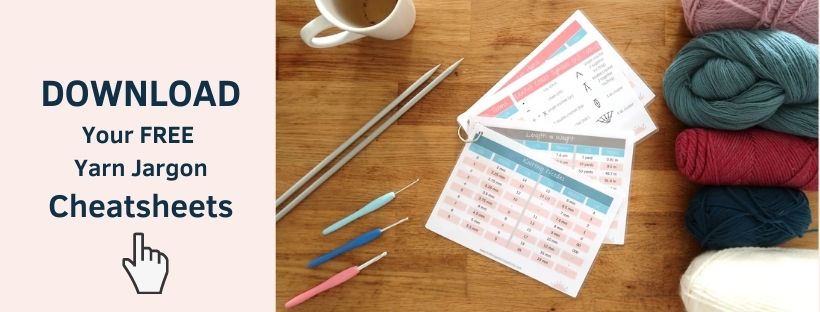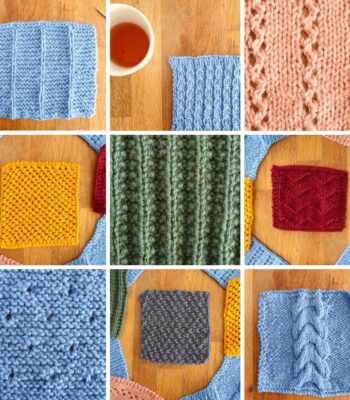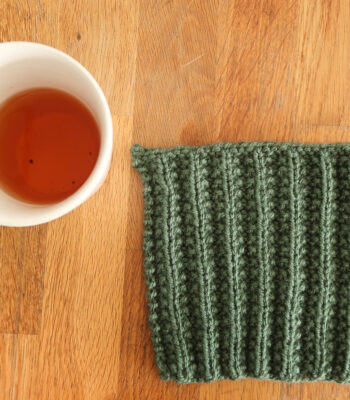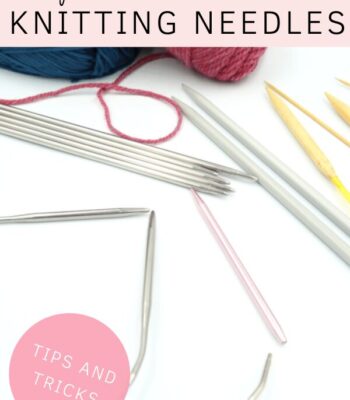What is knitting gauge and why is it so important? How do you measure it, and what do you do if the measurement is off? Gauge is arguably the most intimidating part of reading a knitting pattern (especially for garments). No need to panic! I’m breaking down everything you need to know about gauge so you can make yours with confidence.
No time right now? Pin this gauge tutorial for later!
Scroll down for the free gauge tutorial, but if you’d prefer an ad-free printable PDF tutorial, this blog is a sample chapter from my newest ebook, How to Read Knitting Patterns, which will teach you everything you need to know to decipher patterns and tackle more difficult projects.
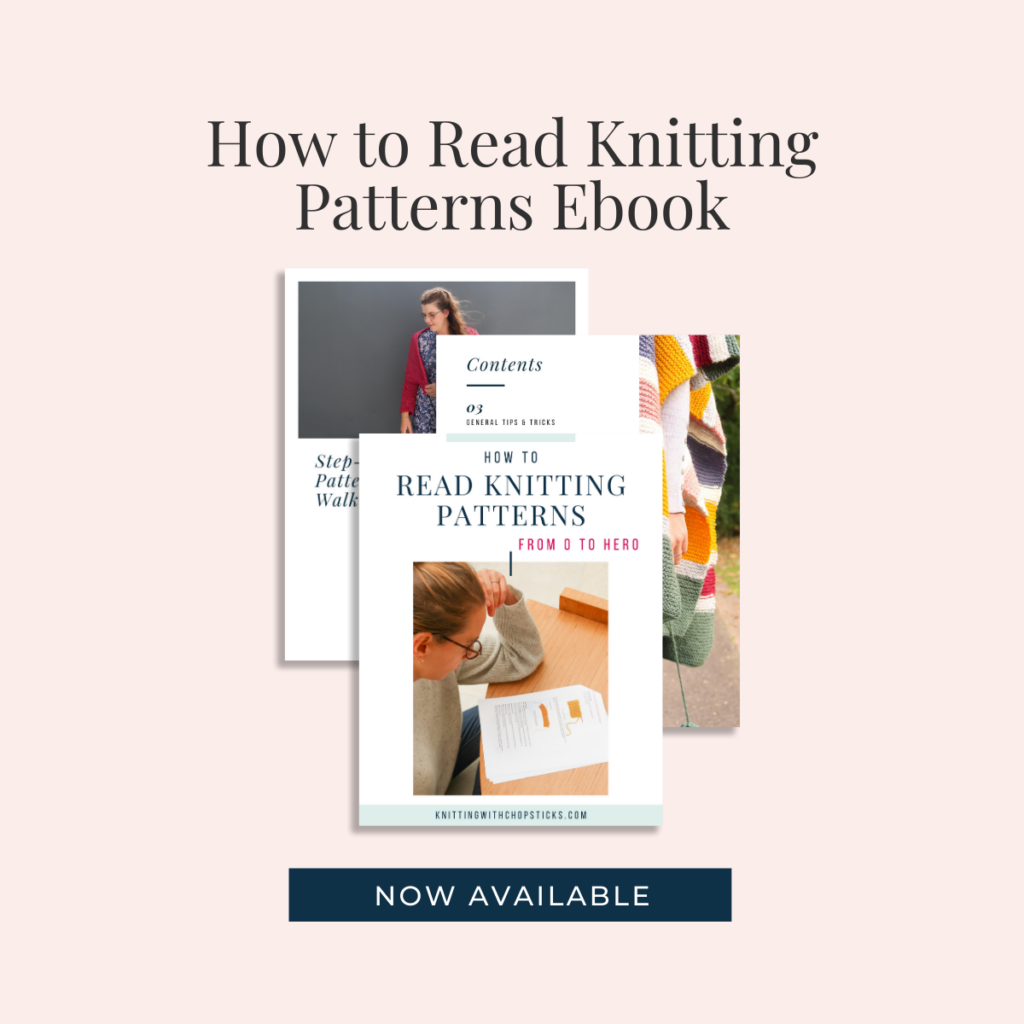
What is Knitting Gauge?
Simply put, the pattern gauge is how many stitches and how many rows you should have (using the recommended yarn and needles) in a 10cm or 4” square. Please take note that while 10cm/4” is the traditional size, some designers may not follow this, so double check what size they indicate in the pattern.
Example: The gauge for this pattern is 16 st by 20 rows in stockinette stitch for a 10cm/4” square. This means if you cast on 16 stitches and knit in stockinette stitch for 20 rows, you should have a 10cm/4” square. (FYI, stockinette stitch is when you knit all the stitches on the right side of your project and purl all the stitches on the wrong side on your project.)
It’s important to follow the stitch pattern given in the gauge measurement as some stitch patterns (such as cables) are much tighter than others.
Why You Need a Gauge Swatch
When you’re ready to start a new pattern, making a gauge swatch is the first thing you should do. I know it’s boring, frustrating, and feels like a waste of time, but I promise it’s worth it! (An exception to this rule is a pattern where the final size doesn’t matter, like a blanket, scarf, or shawl. As long as you’re using the recommended yarn weight and needle size, your final product should end up close enough to the intended size.)
For fitted garments and socks, or any time you choose a different yarn or needle than what the pattern recommends, a gauge swatch is a must. Creating one before you start will help ensure the final product is the intended size, and give you an idea of how your yarn will behave (drape, stretch, bleeding, etc).

How to Make a Gauge Swatch
Now that we’re clear on why making a gauge swatch is important, how do you actually make one?
Start by casting on the recommended number of stitches plus 5-10 extras. We add the extra stitches because the edges always behave differently than the stitches in the middle, which can skew your final measurements.
Now, start knitting the given number of rows plus 5-10 extras (for the same reason). It’s very important to make sure you follow the stitch pattern given in the gauge, meaning if the gauge calls for stockinette stitch, you aren’t using garter. Typically, the designer will give the gauge in the main stitch pattern that’s used in the design (it’s easier for us as designers since that’s the gauge we use to make calculations for different sizes in the design, and it makes it more precise for you).
So you’re done knitting and you have a nice little square. The next step is to cast off and block your square. (Refer to page 35 on blocking if you’re unsure how to do that.) I’ll admit that in day-to-day knitting, I rarely block my gauge swatch out of pure laziness (and a desire to not waste a single scrap of precious yarn). Please, DO NOT BE LIKE ME. Even an experienced knitter can get tripped up without blocking as some yarns behave very differently once they’re blocked.
My advice is to start by doing things properly and blocking each and every gauge swatch. With time and experience, you’ll be able to estimate the impact of blocking (and be okay with a certain amount of frogging, or ripping out your project, due to this choice).
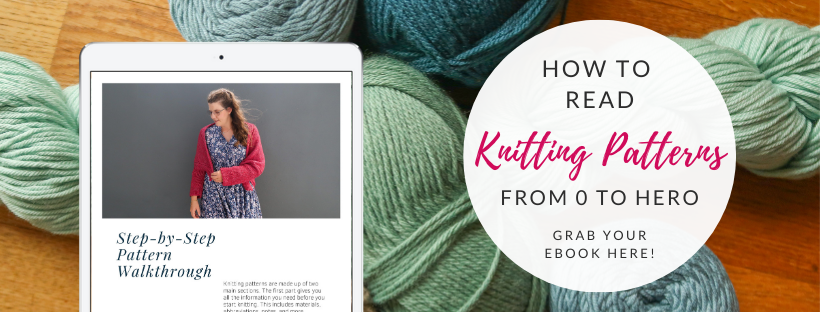
Measure Your Gauge Swatch
Once your square has been blocked, you measure it. Lay it flat on a surface and use a ruler to count how many stitches you have in 10cm/4”. Do the same horizontally, counting the rows. Make sure you’re measuring in the center of your swatch since the edges behave differently.
If you’re feeling unsure about reading your work (seeing how many stitches and rows you made), another option is to do a tiny bit of math. Don’t panic– I’ll explain! When you make your swatch, write down how many stitches you cast and how many rows you knitted. Measure the square in both directions, then use a simple rule of 3 to calculate how many stitches for 10cm/4”.
Example: You cast on 24 stitches and knitted 30 rows. You measure the swatch to be 12cm wide x 15cm high.
Now divide the number of stitches by the width you measured. 24st / 12cm = 2 (stitches per cm). Since you need the number of stitches for 10cm, you then multiply 2st per cm by 10. 2*10 = 20 (stitches per 10cm). To figure out the rows, you divide the number of rows you counted by the height you measured. 25 rows / 15cm = 2.3 (rows per cm). Since you need the number of rows per 10cm, you multiple 2.3 rows per cm by 10 = 23 (rows per 10cm). The math is the exact same if you use inches, but instead of multiplying by 10 cm for everything, you’ll be multiplying by 4”.
Still confused? No worries. here is a calculator to make your life easier!
This method is less precise than counting how many stitches and rows you have per 10cm/4”. I mentioned that the edges tend to behave differently than the center, so when you’re using this method, you’ll be ignoring that fact. This math method works just fine for simple designs that aren’t very fitted, but the first method is better overall.

When Your Gauge Swatch Doesn’t Match
When you’re measuring your completed swatch, this is probably the question in the back of your head. If you carefully measured it and you didn’t get the same result as the given gauge, don’t worry– it happens to everyone sometimes. What to do about it depends on the way in which your swatch is off from the designer’s gauge:
More Stitches
If you end up with more stitches per 10 cm/4”, it means you’re knitting more tightly than the designer. Try going up one or two needle sizes. Alternatively, you could switch to a thicker yarn, but that may impact how the project looks and feels when it’s complete. Sometimes it can also help to switch needle material, while keeping the same size. I tend to knit tighter with bamboo needles than with metal ones. The impact will be more subtle than changing needle size.
Less Stitches
If you end up with less stitches per 10cm/4”, it means you’re knitting looser than the designer. Try going down one or two needles sizes. Like above, switching your needle material may help as well.
More Rows
If you end up with more rows per 10cm/4”, it means your stitches are shorter than the designers and you’re knitting more tightly. Adjusting the gauge height in knitting is trickier than adjusting the width. Loosening up your tension while you knit can help, but generally, if your width is spot on, I wouldn’t worry too much about the height. This is why I give most of my instruction in measurements instead of rows, so your final result isn’t impacted by your height gauge.
Fewer Rows
If you end up with fewer rows per 10cm/4”, it means your stitches are longer than the designer’s and you’re knitting more loosely. Try tightening up your tension when you knit, but similar to above, it’s not easy to adjust.
Grab Your eBook Today!
If you’re a beginner knitter who knows the basic stitches, but can’t seem to make a pattern turn out the way it should, my newest ebook, How to Read Knitting Patterns, is for you! You now understand what knitting gauge is, but there is so much more to learn!
With more than 40 pages chock full of information, photos, and real-life examples, I’ll take you from confused to confident. You’ll learn all the pattern jargon, tips and tricks, along with how to assemble and block your project at the end. Grab your copy now and open the door to endless projects!



